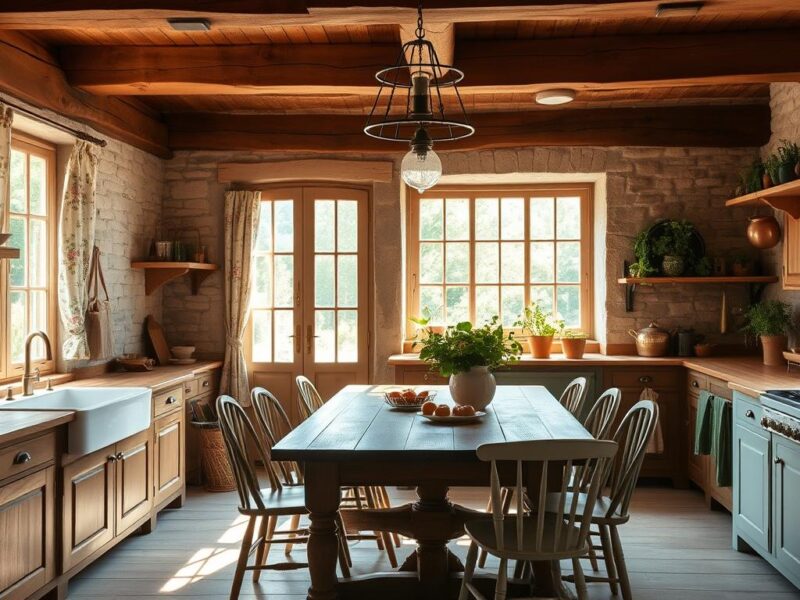The heart of any French farmhouse kitchen is undoubtedly its island—a perfect marriage of rustic charm and practical functionality. These centerpieces blend weathered woods, natural stone, and vintage elements to create spaces that feel both timeless and inviting. Whether you’re planning a complete kitchen renovation or simply looking to refresh your existing space, these French farmhouse kitchen island ideas will inspire you to create a cooking area that exudes authentic European elegance while meeting the demands of modern life.
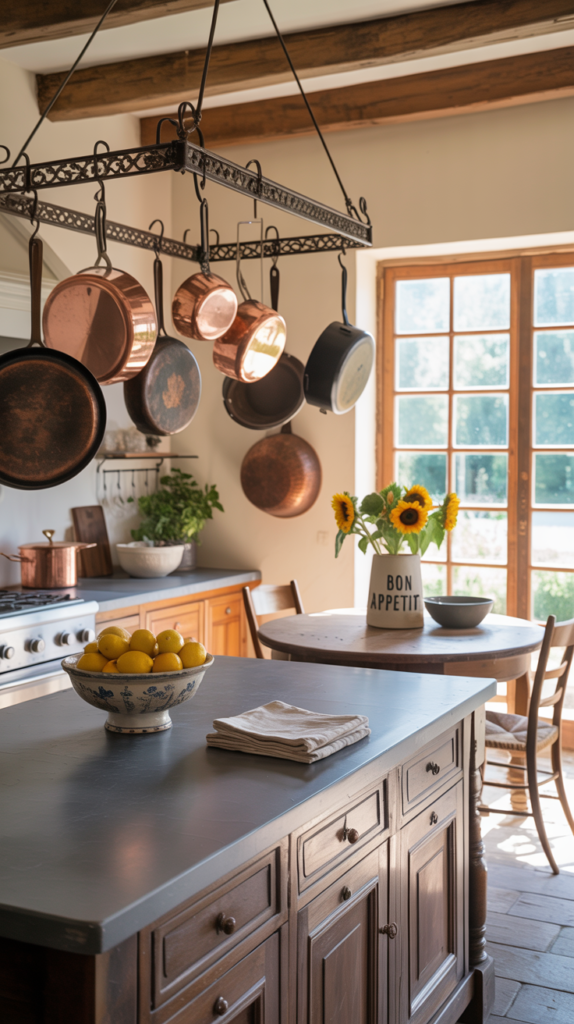
1. Reclaimed Wood Islands with Character
Nothing captures the essence of French farmhouse style quite like reclaimed wood. These weathered treasures bring instant history and character to your kitchen island. Look for oak, pine, or walnut pieces with visible knots, grain patterns, and even a few imperfections that tell a story.
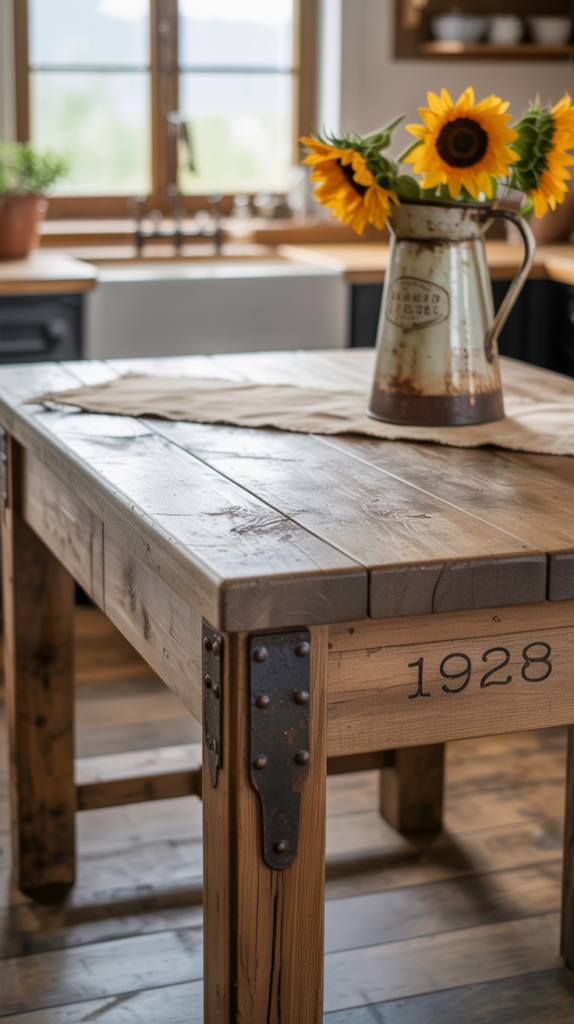
For an authentic look, consider wood salvaged from old barns, wine barrels, or antique furniture. Pair your reclaimed wood island base with a contrasting countertop like honed marble or limestone for that perfect balance of rustic and refined that defines French country style.
DIY Tip: Reclaimed Wood Finishing
To preserve the character of reclaimed wood while making it kitchen-friendly:
- Clean thoroughly with a mild soap solution
- Sand lightly to remove splinters while maintaining patina
- Apply food-safe sealant like tung oil or beeswax
- Consider a glass top for food prep areas if wood is very rustic
2. Limestone Countertops for Timeless Appeal
Limestone countertops are quintessentially French and bring an earthy, timeless quality to farmhouse kitchen islands. This natural stone, often quarried in the French countryside, features subtle color variations in creamy whites, beiges, and grays that perfectly complement wooden island bases.
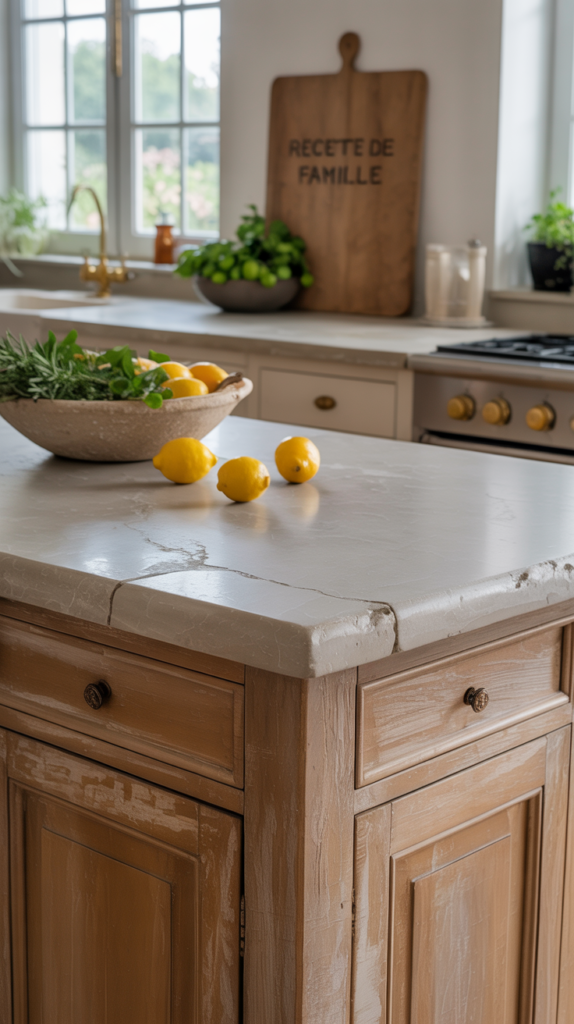
Unlike polished marble, limestone offers a more casual, lived-in feel with its matte finish and subtle fossil markings. While it requires some maintenance, this natural patina that develops over time is part of its authentic charm. For a truly French look, opt for a honed finish rather than polished, and consider an edge profile with a slight bevel or rounded edge.
Designer Tip: Limestone is porous and can stain, so be sure to seal it properly every 6-12 months. Many French homeowners embrace the developing patina as part of the stone’s character and story.
3. Open Shelving with Woven Storage Baskets
Incorporate the practical farmhouse spirit by adding open shelving to your kitchen island. This French country staple provides both storage and display space for your most beautiful kitchenware and collected treasures.

Woven market baskets—the kind you might find at a French countryside market—add texture and warmth while keeping smaller items organized. Arrange them alongside stacked white plates, copper cookware, and perhaps a few carefully selected antique pieces for that collected-over-time feel that’s essential to authentic French farmhouse style.
For a truly functional approach, designate different baskets for various purposes: one for linens, another for produce, and perhaps a third for baking supplies. This combination of beauty and practicality is the essence of French farmhouse design.
4. Vintage-Inspired Pendant Lighting
The right lighting transforms your French farmhouse kitchen island from merely functional to truly magical. Look for pendant lights with aged brass, copper, or wrought iron finishes that appear to have illuminated family meals for generations.
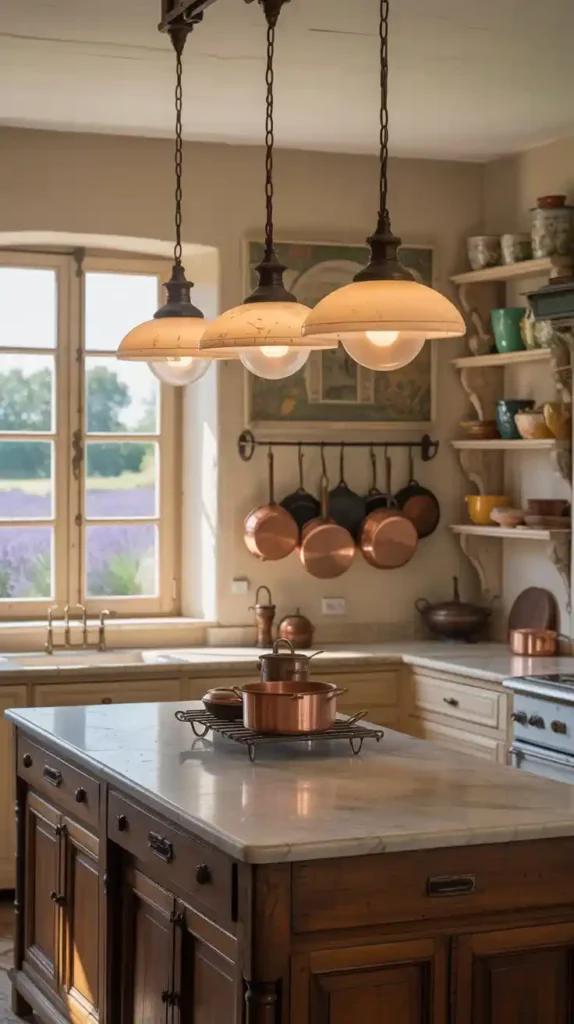
Glass lantern-style pendants with candle-shaped bulbs evoke the romance of French countryside evenings, while simple metal dome shades offer a more rustic, utilitarian feel. For authentic charm, look for fixtures with subtle imperfections or patina—or age new fixtures yourself with specialized finishes.
“Lighting is the jewelry of the home. In a French farmhouse kitchen, pendant lights should feel like cherished heirlooms passed down through generations.”
— Interior Designer Amitha Verma
Install pendants at varying heights for visual interest, or group three identical fixtures for a balanced, symmetrical look. Remember that in French design, lighting is as much about ambiance as illumination.
5. Integrated Farmhouse Sink
A true statement piece in any French farmhouse kitchen is the iconic farmhouse sink—and incorporating one directly into your island creates both a stunning focal point and a practical workspace. These deep, apron-front sinks originated in an era when large basins were needed for washing everything from produce to laundry.

For authentic French country style, choose a white fireclay or porcelain sink with a simple, rounded apron front. Position it to face outward toward your dining or living area to facilitate conversation while preparing meals—a cornerstone of French entertaining.
Complete the look with a vintage-inspired bridge faucet in unlacquered brass or brushed nickel that will develop a beautiful patina over time. This combination of form and function embodies the practical luxury that defines French farmhouse design.
6. Furniture-Style Details and Turned Legs
In authentic French farmhouse kitchens, islands often resemble freestanding furniture pieces rather than built-in cabinetry. This approach creates a collected, evolved-over-time aesthetic that’s central to French country charm.

Look for islands with elegantly turned legs, carved details, and decorative molding that mimic antique French furniture. These elements add architectural interest and a sense of history to your kitchen. For an authentic touch, consider a distressed or hand-painted finish in soft blues, greens, or creams—colors frequently found in French provincial homes.
Key Furniture-Style Elements
- Turned or fluted legs reminiscent of antique tables
- Carved details or corbels under the countertop edge
- Beadboard or raised panel sides
- Furniture-style feet instead of a toe kick
- Distressed or hand-painted finish
This approach allows your island to serve as a true centerpiece—a beautiful furniture item that happens to be incredibly functional for cooking and gathering.
7. Copper Cookware Display
Nothing evokes the spirit of a French country kitchen quite like gleaming copper cookware. Incorporating a pot rack or display area into your kitchen island design creates both a stunning visual element and practical storage for these cherished culinary tools.
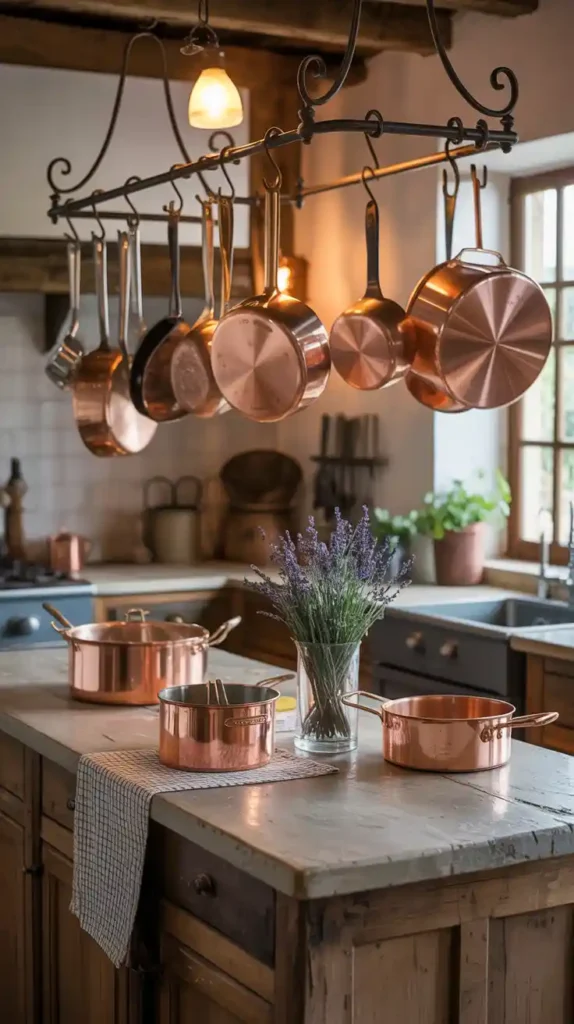
Consider a wrought iron pot rack suspended directly above your island, or incorporate open shelving into the island itself to showcase your collection. The warm, rosy glow of copper brings instant warmth and authenticity to your space—even a few carefully selected pieces can make a significant impact.
For the most authentic look, mix various sizes and shapes of copper cookware, including traditional French pieces like the iconic copper jam pan, fish poacher, or madeleine molds. Allow them to develop a natural patina for that lived-in French farmhouse feel, or keep them polished for more formal French country elegance.
Styling Tip: Intersperse your copper collection with a few ceramic pitchers or earthenware vessels for an authentic, collected-over-time appearance that’s quintessentially French.
8. Built-In Herb Garden
Fresh herbs are essential to French cooking, and incorporating a small herb garden directly into your kitchen island brings both practicality and natural beauty to your space. This charming feature connects your kitchen to the French tradition of garden-to-table cooking.

Design a dedicated section of your island with a shallow trough that can hold small terracotta pots of rosemary, thyme, basil, and lavender—herbs commonly found in Provençal cooking. For a more integrated approach, consider a built-in planter with proper drainage that becomes part of the island’s structure.
Position your herb garden near a window if possible, or supplement with a small grow light for year-round freshness. The fragrance of fresh herbs will infuse your kitchen with the authentic scents of the French countryside, while their varying heights and textures add visual interest to your island.
9. Mixed Materials for Authentic Character
True French farmhouse style embraces a collected-over-time aesthetic, where different materials come together to tell a story of generations. Apply this philosophy to your kitchen island by thoughtfully combining various materials for rich visual texture and authentic character.
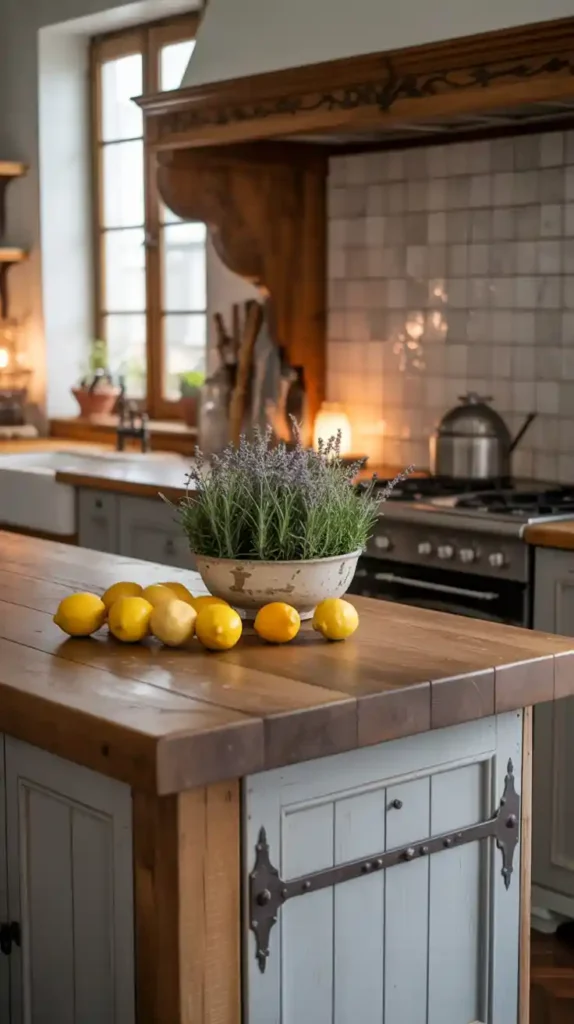
Consider a reclaimed wood base paired with a marble or limestone countertop, accented with wrought iron hardware and perhaps copper details. This layering of materials creates depth and interest while remaining true to French farmhouse traditions.
Traditional Materials
- Weathered or painted woods
- Natural stone (limestone, marble)
- Wrought iron
- Copper and brass
- Terracotta
Authentic Combinations
- Painted wood base with stone top
- Wood countertop with stone inlay
- Metal accents on wooden structure
- Chicken wire cabinet inserts
- Terracotta tile details
For added authenticity, incorporate elements with visible age and patina—perhaps a section of antique butcher block or reclaimed tiles integrated into your countertop. These thoughtful combinations create a kitchen island that feels as though it evolved naturally over decades.
10. Comfortable, Casual Seating
The French approach to dining emphasizes gathering, conversation, and lingering over meals—principles that should extend to your kitchen island seating. Choose options that invite family and guests to settle in comfortably while maintaining that distinctive French farmhouse aesthetic.
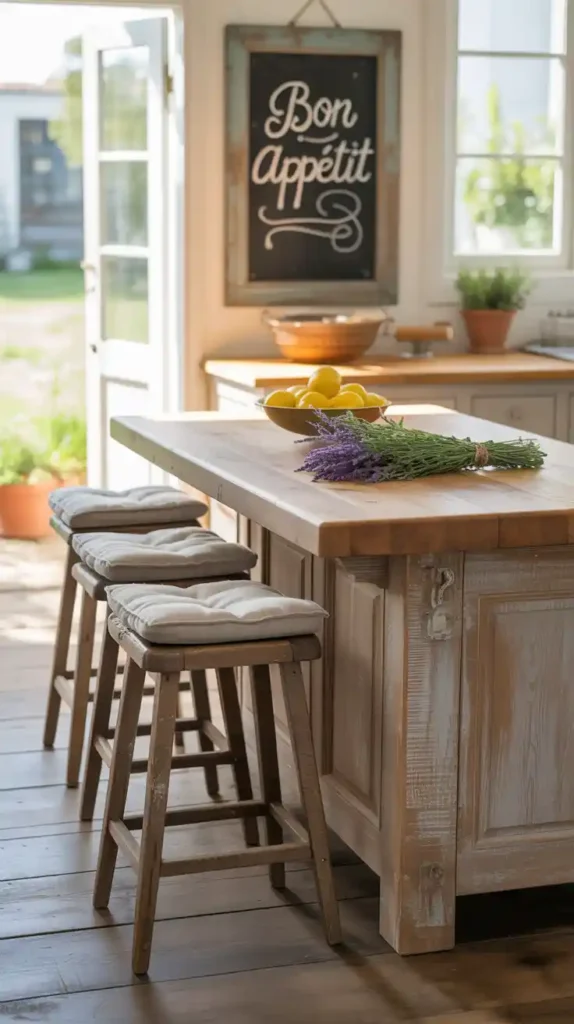
Wooden counter stools with rush or woven seats offer authentic charm, especially when slightly mismatched for that collected-over-time feel. For added comfort, consider simple linen cushions in neutral tones or classic French patterns like toile or ticking stripe.
X-back or cafe chairs in a distressed finish provide another authentic option, particularly for islands with a lower counter height designed for proper dining. Whatever style you choose, aim for seating that feels casual yet refined—comfortable enough for lingering conversations but still elegantly French in its simplicity.
“In a French home, the kitchen is where life happens. Your island seating should invite people to not just eat, but to connect, converse, and create memories.”
11. Decorative Molding and Carved Details
French design celebrates architectural details, and your kitchen island offers the perfect canvas for incorporating decorative moldings and carved elements that elevate it from functional to truly special.
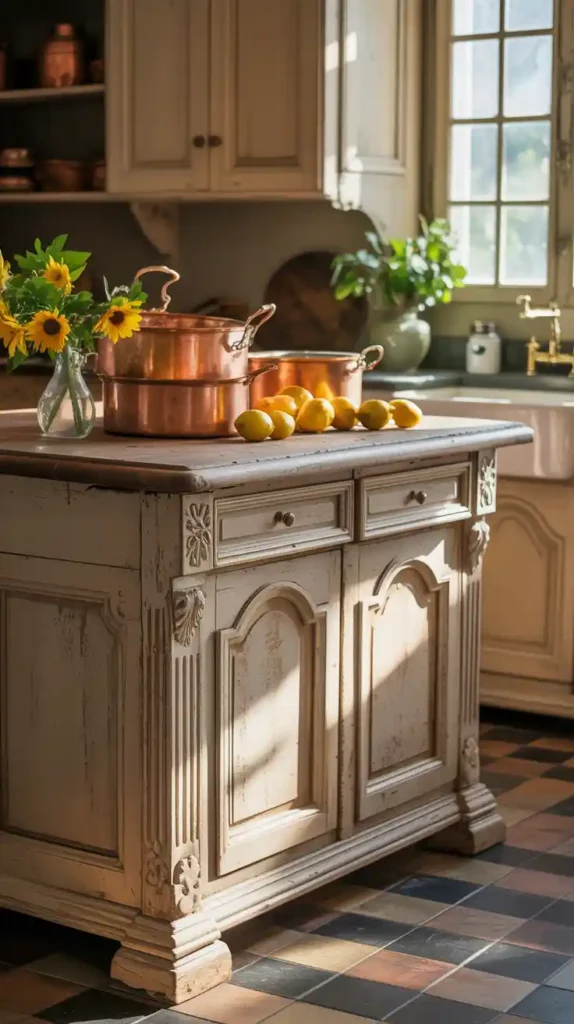
Look for islands with fluted columns, carved corbels supporting the countertop overhang, or decorative panel moldings on the sides. These architectural elements reference the refined detailing found in French provincial furniture and add a sense of history and craftsmanship to your kitchen.
For authentic character, consider details with a slightly distressed or aged finish that suggests generations of use. Even simple beadboard paneling or a decorative toe kick can add that touch of French elegance that distinguishes true farmhouse style from more rustic interpretations.
Design Tip: For maximum impact, focus decorative details on the island’s most visible sides, particularly those facing living or dining areas. This creates a beautiful transition between spaces in an open floor plan.
12. Antique or Aged Hardware
The finishing touches often make the biggest difference in achieving authentic French farmhouse style. Hardware elements like drawer pulls, cabinet knobs, and decorative hinges add character and historical context to your kitchen island.
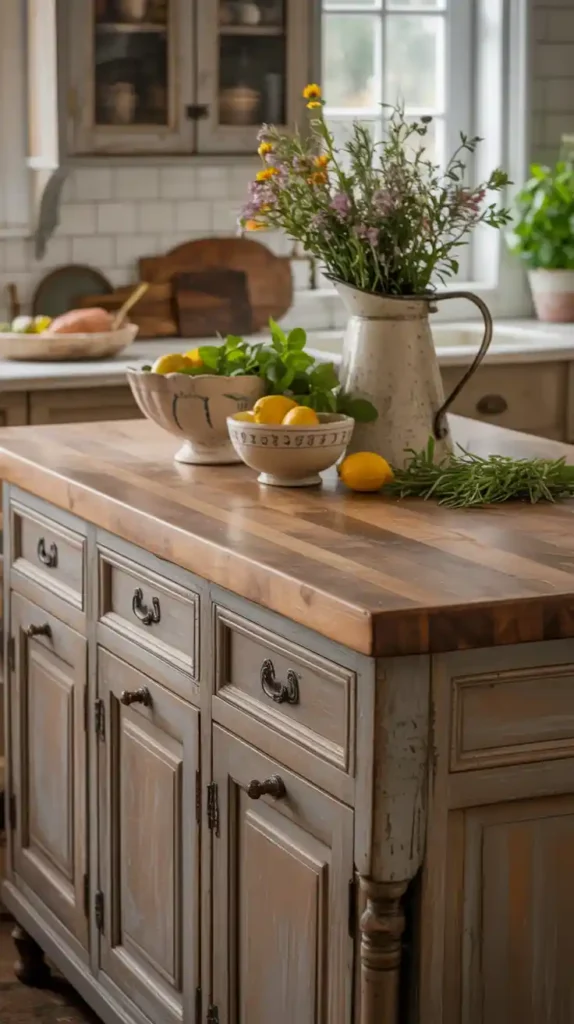
Seek out hardware with an aged patina in materials like brass, iron, or bronze. Bin pulls, drop handles, and ornate backplates all reference traditional French cabinetry. For an authentic touch, consider mixing different styles of hardware as would naturally occur in a home that evolved over generations.
Don’t overlook functional hardware like hinges and latches—exposed iron strap hinges or simple brass latches add charming detail while reinforcing the farmhouse aesthetic. Even decorative nail heads or tacks can add that perfect finishing touch to wooden elements.
Authentic Hardware Finishes
- Unlacquered brass (develops natural patina)
- Hand-forged iron (slightly irregular)
- Aged bronze (darkened with highlights)
- Pewter (soft, matte gray finish)
- Copper (warm tone that darkens over time)
Bringing Your French Farmhouse Kitchen Island to Life
Creating an authentic French farmhouse kitchen island is about more than following design trends—it’s about crafting a space that feels lived-in, loved, and layered with history. Whether you incorporate all twelve of these ideas or select just a few that resonate with your personal style, the key is to embrace the French philosophy of blending beauty with practicality.
Remember that true French farmhouse style develops organically over time. Allow your island to evolve as you add personal touches, collected treasures, and the natural patina that comes from a well-used and well-loved kitchen. The result will be a space that not only looks authentically French but also functions beautifully for your modern life.

